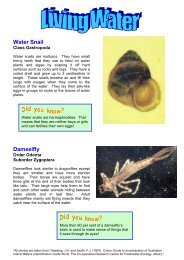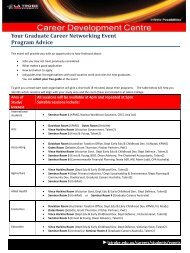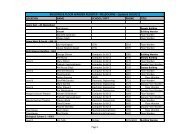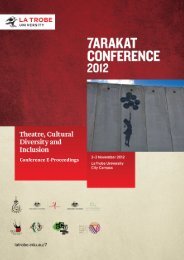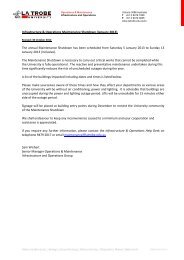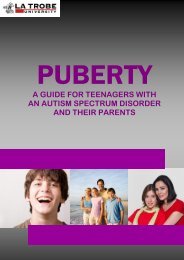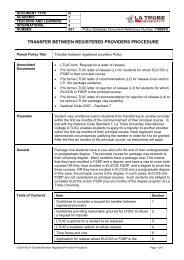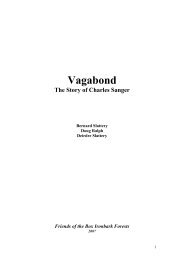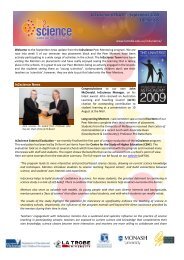Project Report - La Trobe University
Project Report - La Trobe University
Project Report - La Trobe University
You also want an ePaper? Increase the reach of your titles
YUMPU automatically turns print PDFs into web optimized ePapers that Google loves.
Apalis (Ombin) Abaggoy reviews yet another English<br />
version of a story while his son Ayfa (Edmar) Abaggoy<br />
sits in his lap.<br />
Indigenizing Education in a Kalinga Public School | 24<br />
application was not successful, or without the<br />
input of professional artists, for example). This<br />
approach meant that we could easily adapt to<br />
changing circumstances and unexpected challenges<br />
(like when Edwin returned to Australia for almost<br />
a month in response to a medical emergency). It<br />
also meant that we could easily take all<br />
opportunities as they arose, like the chance to<br />
incorporate the work of the Ang Ilustrador ng<br />
Kabataan illustrators.<br />
…except time<br />
The only parameter which we didn’t treat flexibly<br />
was the project timeframe: we were adamant that<br />
we must complete the project within five months.<br />
This was useful in that it forced us to produce<br />
something fast without the luxury of stretching the<br />
timeline out indefinitely: we needed to produce<br />
something tangible before we left Chananaw when<br />
the five months was up.<br />
The right people for the job<br />
In terms of us as the two individuals driving the<br />
project, two characteristics probably contributed a<br />
lot to its success. First, the fact that we are a couple<br />
meant that we knew each other well, enjoyed<br />
working together and could provide a lot of<br />
support to each other in a way impossible if we<br />
weren’t already so close, to the point of taking over<br />
from each other when needed. In terms of being<br />
foreigners, the fact that we’d lived in the<br />
Philippines for a year before commencing the<br />
project meant that we didn’t have any cultural<br />
adjustment issues and we already had strong social<br />
and professional networks to draw on.<br />
Genuine partnerships, not charity<br />
We focused on only building genuine working<br />
partnerships. We weren’t seeking charitable<br />
support for the Ichananaw – not least since we<br />
consider them a resourceful, capable community<br />
with the ability to solve their own problems<br />
without the need for charity. Genuine partnerships,<br />
however, where each side contributed and each<br />
gained something from the interaction, were the<br />
vehicle we used to achieve those aspects of our<br />
project which we couldn’t achieve alone. This was<br />
important, in our eyes, to maintain the dignity of<br />
the Ichananaw as the official project beneficiary.<br />
But it also meant that, even though most of the<br />
contributions to our project were volunteered, all<br />
involved were serious and committed and<br />
produced work of a high quality.


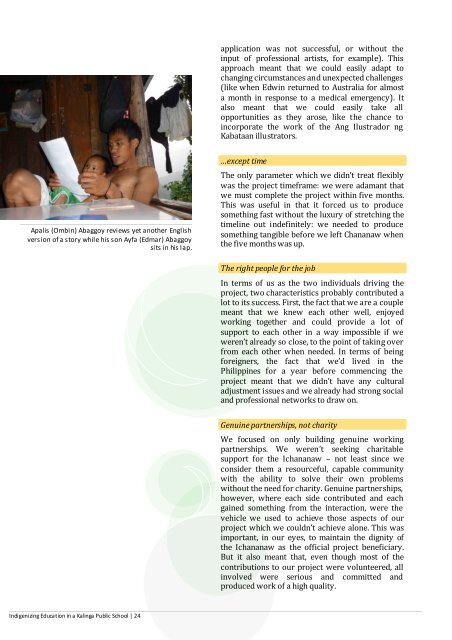
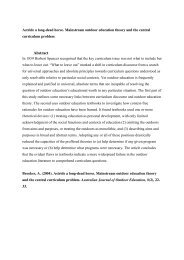
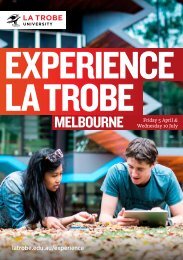
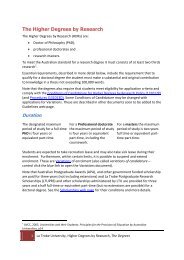
![Ottoman Empire course brochure [PDF 612KB] - La Trobe University](https://img.yumpu.com/12001562/1/184x260/ottoman-empire-course-brochure-pdf-612kb-la-trobe-university.jpg?quality=85)
![Getting Ready to Talk Manual [PDF 315KB] - La Trobe University](https://img.yumpu.com/11430807/1/190x245/getting-ready-to-talk-manual-pdf-315kb-la-trobe-university.jpg?quality=85)
